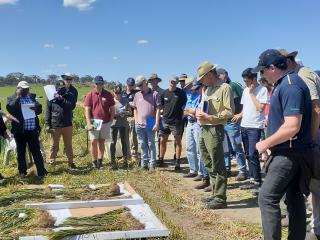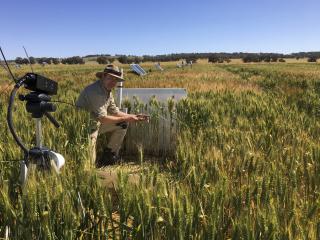Western Australia
october 15, 2020

DPIRD research scientist Dr Ben Biddulph (left) addresses the crowd at the recent Dale frost research field day, where research on ice nucleation active bacteria was discussed.
A major breakthrough in frost research has been achieved, with the discovery that a type of bacteria found on some stubbles could elevate the risk of damage to cereal crops – particularly after rainfall events.
The research is part of a two year project by the Department of Primary Industries and Regional Development, funded by the Council of Grain Growers Organisations (COGGO).

DPIRD research scientist Dr Ben Biddulph uses a thermal camera to inspect crop residues at the department’s Dale research site, as part of a trial to confirm frost damage at warmer temperatures in crops associated with stubble retention.
Field trials over the past two seasons at the department’s Dale frost nursery show wheat grown on stubbles with ice nucleation active (INA) bacteria froze from the ground up at temperatures four to five degrees warmer than without stubble.
Department research scientist Ben Biddulph said INA bacteria produce a protein that increases the freezing point of water, heightening the risk of frost damage to wet crops after slow moving cold fronts.
Dr Biddulph said while the phenomenon had been observed in horticulture crops, this was the first time it had been confirmed in Western Australian cereal crops.
“What we think is happening is that nutrient starved INA bacteria on some stubbles produces a protein in the presence of cold and wet conditions prior to frost events that results in ice forming on the stubble, which causes plants it comes into contact with to freeze at warmer temperatures,” he said.
“Samples from field trials when tested in the laboratory showed ice formation on stubble at - 6°C, then old senesced leaves froze at slightly lower temperatures from - 6 to - 8°C, while the flag leaf and upper canopy did not freeze but supercooled down to - 12°C.”
The ice formation on stubble and then freezing of nearby plants from the bottom up was confirmed by in-field thermography undertaken by the department during mild frost events in 2019 and 2020.
“We replicated stem frost damage typically observed with frost after rainfall in trials by spraying the canopies with water and the protein produced by the INA bacteria the evening before a frost,” Dr Biddulph said.
“Pure water alone did not cause frost damage, indicating it is the bacterial ice nucleating proteins that contributes to the frost damage.”
During a frost, it can take 20-30 minutes for a tiller and associated head to freeze from when ice is first formed at the base of the plant and then travel up the stem and freeze the whole head.
Dr Biddulph said the research was the most exciting leap in frost research in the past five years and puts the science behind anecdotal evidence from farmers and past GRDC and DPIRD funded trials.
“Over the past three years researchers have quantified increased frost damage in wheat with stubble retention and also observed more frost damage in oats with the INA bacteria Pseudomonas syringea associated with stripe or halo blight,” he said.
“The preliminary findings from this project indicate the increased incidence is linked to the bacteria, most likely Pseudomonas syringae living on decaying crop residues and the ice nucleating proteins they produce.”
The preliminary findings from the project were discussed at the department’s recent Dale Research Site Field Day, which attracted about 80 scientists, students, consultants and farmers.
The project aims to develop protocols to identify and quantify INA bacteria in cereals to support research and diagnosis, determine the presence of INA bacteria in cereal crops and rainfall, and assess the potential contribution of INA bacteria to increasing frost damage.
“More work is required to develop a data set to better understand the process, as well as the genetic variance and why we see that occurs,” Dr Biddulph said.
“We need to determine if INA bacteria are part of a continuous cycle in the farming system, whether different crop residues have different bacteria and how different amounts of rainfall prior to frost events influence different bacterial populations and their ice nucleating activity.”
While Dr Biddulph said the research findings were not a ‘silver bullet’ to frost mitigation, he said it opened the door to additional paddock management packages, treatments and plant breeding strategies to protect crops from the risk of frost damage to be considered.
“In the horticulture production around the world bactericides and agronomic practises are used to manage INA bacteria and subsequent bacterial blight, while in other crops genetic variation for bacterial blight is used in breeding programs,” he said.
“This discovery is just one piece in the puzzle in the learning curve and improving crop management to reduce the risk of frost impacting on crop performance and profitability.”
Meanwhile, the department’s Frost Identification Guide for Cereals has been updated with new high-resolution photographs and information on identifying stem elongation frost damage in wheat and flowering frost damage in barley.
The guide can be downloaded for free here, where there is more information on frost risk management.